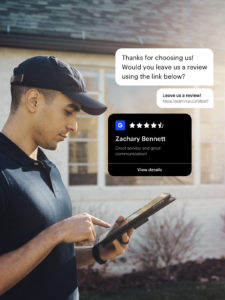For many multi-location businesses, managing online reputation can be an uphill battle. Collecting reviews, responding to reviews, ensuring those reviews accurately reflect a typical customer experience, and finding ways to improve the quality of reviews is challenging and time consuming. Add in businesses that must manage dozens, hundreds, or even thousands of business locations and it’s a perfect storm.
But we’re here to help. Read on to learn
- How to develop an effective online reputation program
- How to get started with Google reviews
- How to improve your review requests
- How to optimize your review request program
- How to get started

How to develop an effective online reputation program
Step 1: Gather information
Speak to each of your brand locations, dealers, and/or franchisees about their needs and current processes for collecting reviews. Identify what’s working and what’s not working and how you can create a single process that works for every location.
Consider asking the following questions to each franchisee owner and/or store manager:
- Do you know how many reviews have been posted online for your store location?
- How are you currently collecting reviews from customers?
- How many reviews do you collect on average?
- How are you following up on reviews for your specific location?
- What would you like to see in a new online reputation management program?
Step 2: Identify goals and KPIs to track
Before you implement an online reputation program, it’s critical that you document your specific goals. What is your desired outcome of the program and how will you measure it?
Once you’ve determined your goals and KPIs, create a dashboard to help you track progress and easily share results. Your Reputation Management software provider should also be able to help you with this.
Step 3: Involve key stakeholders
Identify which departments and team members you will need to include in your online reputation management program.
Consider the following questions as you identify who should be involved in the program:
- Who will be the gatekeeper of the incoming review data?
- Who will analyze the data for trends?
- Who will route reviews to the right internal team?
- Who will respond to negative reviews?
- Who will close the loop on relevant customer feedback?
Also, try to find an executive sponsor to back your goals for this initiative. They can not only provide support, but can help evangelize the program throughout the organization.
Step 4: Map out the desired customer experience
As you implement your online reputation management program and create a consistent customer experience for each location, consider what that process looks like and document your best-case scenario.
Consider the process from both your internal perspective and the customer experience. Be sure to answer the following questions:
- When will the customer receive a review request?
- Who will send the request or how will the request be automatically triggered?
- How and on what channel will the customer receive the review request (and what will be included in that request)?
- How many steps will be required of your customer to complete and post a review?
- Are there any steps you can automate internally to streamline the request of reviews?
Step 5: Document program ownership
Each online reputation program should include at least three areas of ownership: requesting reviews, responding to reviews, and closing the loop—apply changes to the business operationally. Determine which internal team or department will manage each area and how the handoff between steps should be implemented.
Your program ownership document should include:
- The team or department responsible to ask for reviews
How will they ask for reviews?
Where will they pull contacts?
What will the message to customers be? - The team or department responsible for responding to reviews
How will they follow up with negative reviews?
How will they route reviews to the right person for a specific follow up?
What messaging will they use to respond publicly to negative reviews? - The team or department responsible for implementing changes to the business
How will they identify specific patterns or trends in the review data?
What baseline will be required in order to implement changes across the business?
Step 6: Claim and maintain your Google My Business listings
If you haven’t already, claim each location’s Google My Business listing and then make a plan to check each one for accuracy.
As you update and maintain your Google My Business listings, include the following:
- Business hours (including holidays)
- Phone number (including a textable number)
- Website link
- Location address
- Photos of each specific location
Step 7: Conduct a pilot program
Start your program roll out with a small pilot program. Identify the contacts or specific locations you want to start with on a smaller scale and execute your program. Track your KPIs in those areas to see how your program performs. Determine beforehand what success looks like so you’ll know when it’s time to do a broader program launch.
In your initial run of review requests, be sure to:
- Personalize your ask by including each customer’s name in the review request
- Include the link to the review site to reduce friction for the customer’s process
- Thank each customer for their business!
Step 8: Roll out your program to all locations
Once your pilot program is complete, analyze your results. If your customer experience was positive, your internal team was clear on their responsibilities and executed each task in a timely manner, and your customers engaged with your ask for reviews, it’s time to roll out the program to your entire contact list and each location.
As you move from beta to a live online reputation management program, don’t forget to:
- Identify checkpoints to make sure everything is running smoothly
- Consider different review request methods (e.g. texting your review request vs. email)
Step 9: Report on performance
After your online reputation management program rolls out to your entire business (and each location), don’t forget to report on the performance of the program.
In your report, include the following:
- Employee (corporate and local) feedback on how the program was executed
- Total number of reviews collected
- Specific trends or patterns that will inform change for your business

How to get started with Google Reviews
Google Reviews impact your online reputation more than any other review site. Because they are tied directly to your search ranking when a new lead or current customer searches for a business like yours on Google, it’s a smart idea to focus your efforts on Google Reviews first.
If you haven’t already, it’s time to claim your Google My Business listing—for each store location. After you have claimed your listing, be sure to verify your account via email, phone, or email to ensure only you have access to edit the details on your listing(s).
(For detailed instructions on how to add or claim your business listing with Google, click here. For detailed instructions on how to verify your account with Google, click here.)
To optimize your Google My Business listing, keep all of your information up-to-date. Include correct business hours, a phone number (include a textable number if you have one), address, website link, and photos and videos of each specific location.

How to improve your review requests
To improve your online review requests and increase the quantity and quality of reviews your customers leave for you online, follow these tips and tricks:
- Consider the timing of the review ask
As many as 70% of all reviews are generated from post-transactional review request emails. The key in this data point is in the timing. After your customer purchases a product or service, follow up with a request for a review immediately. The more space between the purchase and the review request will only negatively impact the number of reviews your business will capture from happy customers.
- Review your platform options
Nearly 60% of all online reviews are posted directly from a mobile device. And it’s no surprise—consumers spend nearly 4 hours every day on their phones (that’s more time than they watch TV each day). When you ask for a review in the right channel, your customers are more likely to complete your request. Switch from asking via email (a 20% average open rate) to asking for reviews via text messages (a 98% open rate).
- Increase the chances of a review completion
By communicating with customers the way they want to communicate with you, you’ll increase your chances of a review completion while also building a positive relationship with your customer. And because 90% of customers already say they prefer to interact with a brand via text message, it’s a good idea to implement texting with your customer before they complete their purchase. Offer the option to set appointments, check local inventory, connect with local sales reps, and more. You’ll build the relationship before the critical review ask—thereby increasing your chances for a positive review online.

How to optimize your review request program
With multiple locations and a thriving review program, you’re likely to get inundated with more than reviews. Negative reviews, customer service requests, increased web traffic and leads, and more often come up when more customers post reviews online. And whether your review program is routed through one corporate team or to each location individually, you can optimize your review request program to get the best results.
Consider these best practices to optimize your review request program:
- Standardize the ask for reviews across all locations
While some locations might be better at asking for reviews than others, there should be consistency for your brand. Scripts, templates, and even standard times for review asks should be the same for every location in order to create a consistent customer experience. Standardizing when you will ask for reviews is also important. Some data suggests that the best time of day to ask for a review is between 2:00 and 3:00 p.m. or 6:00 and 7:00 p.m. Whatever time of day you do make the ask, be sure to ask your customer within the same 24 hours of a purchase or visit.
- Report on the right data
The data your brand can collect from reviews is incredibly important to improving your customer experience and understanding what you’re doing right as a business. Track review count, average star rating, and search result ranking for each location at least quarterly. The more reviews you have and the higher your average review rating climbs, your search result ranking should improve. And for many industries, showing up on third-party sites (outside of Google) is just as critical.
- Route negative reviews and other messages to the right customer service team
Any negative reviews or messages or even customer service requests need to be routed and escalated to the right department or team quickly and efficiently. Location-specific requests should always be delivered to the correct local staff, connecting local customers with their local business.
How to get started
Getting great reviews takes a lot of work. And there are a lot of moving parts for any team to manage. But with the right tools, you can minimize effort and maximize impact. Learn how Podium can help you optimize your reviews here.




